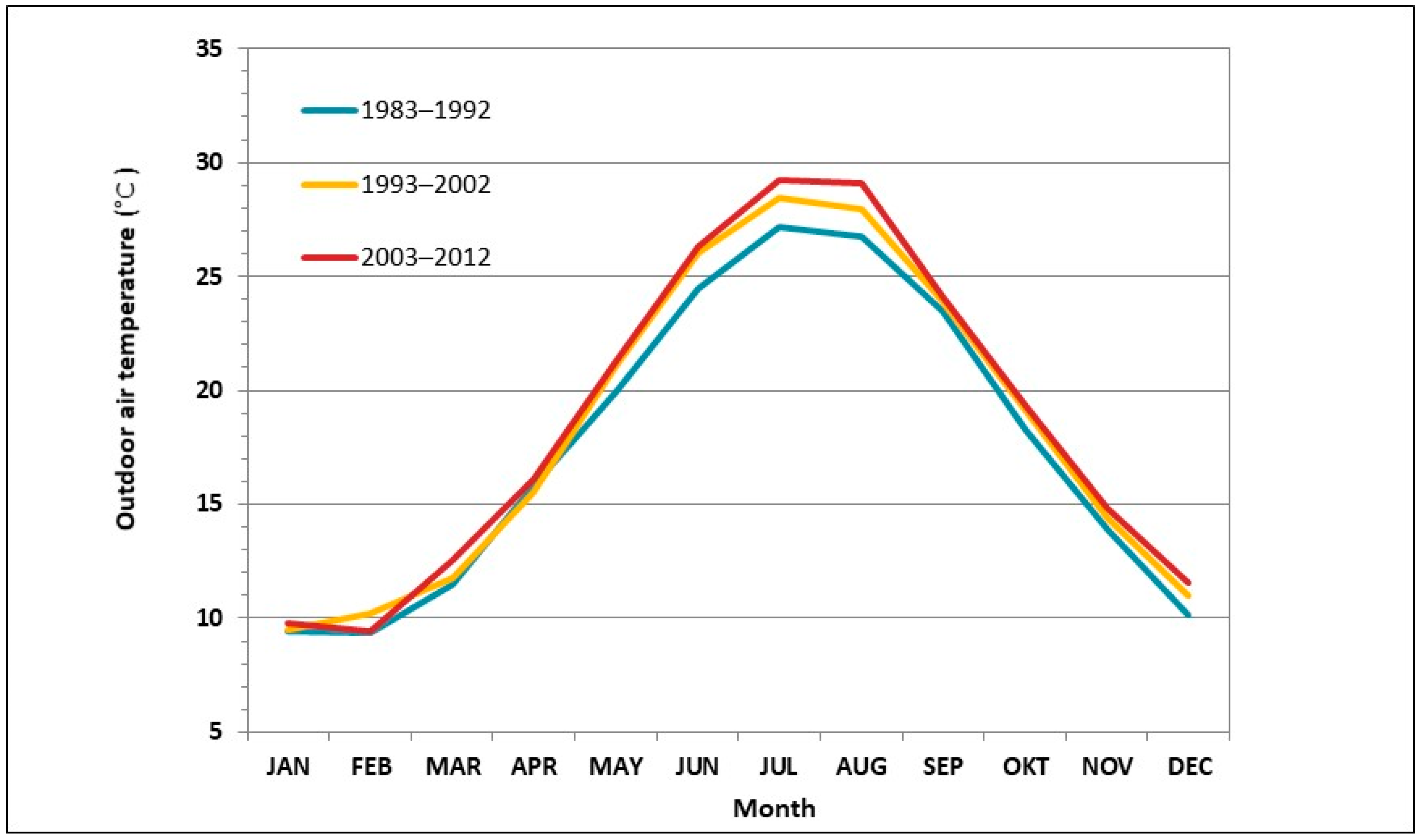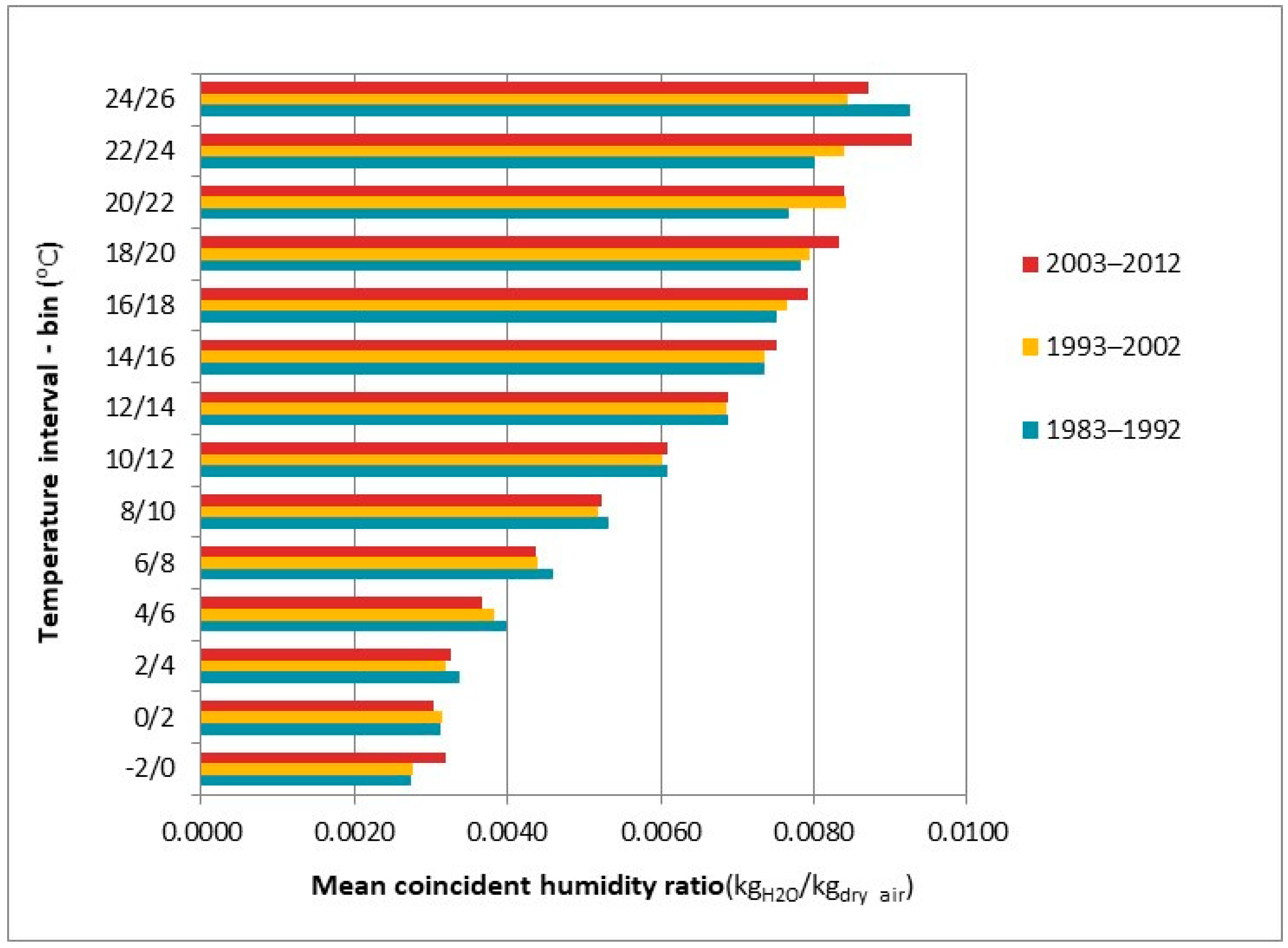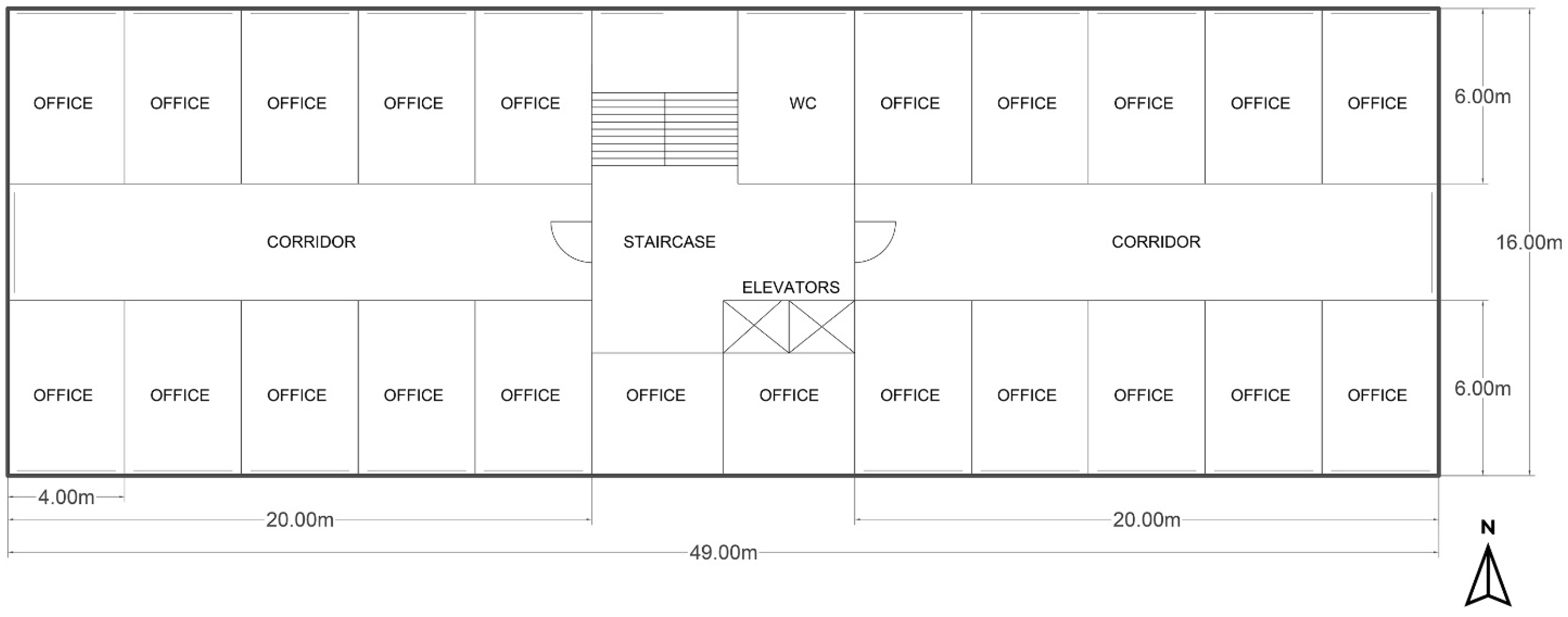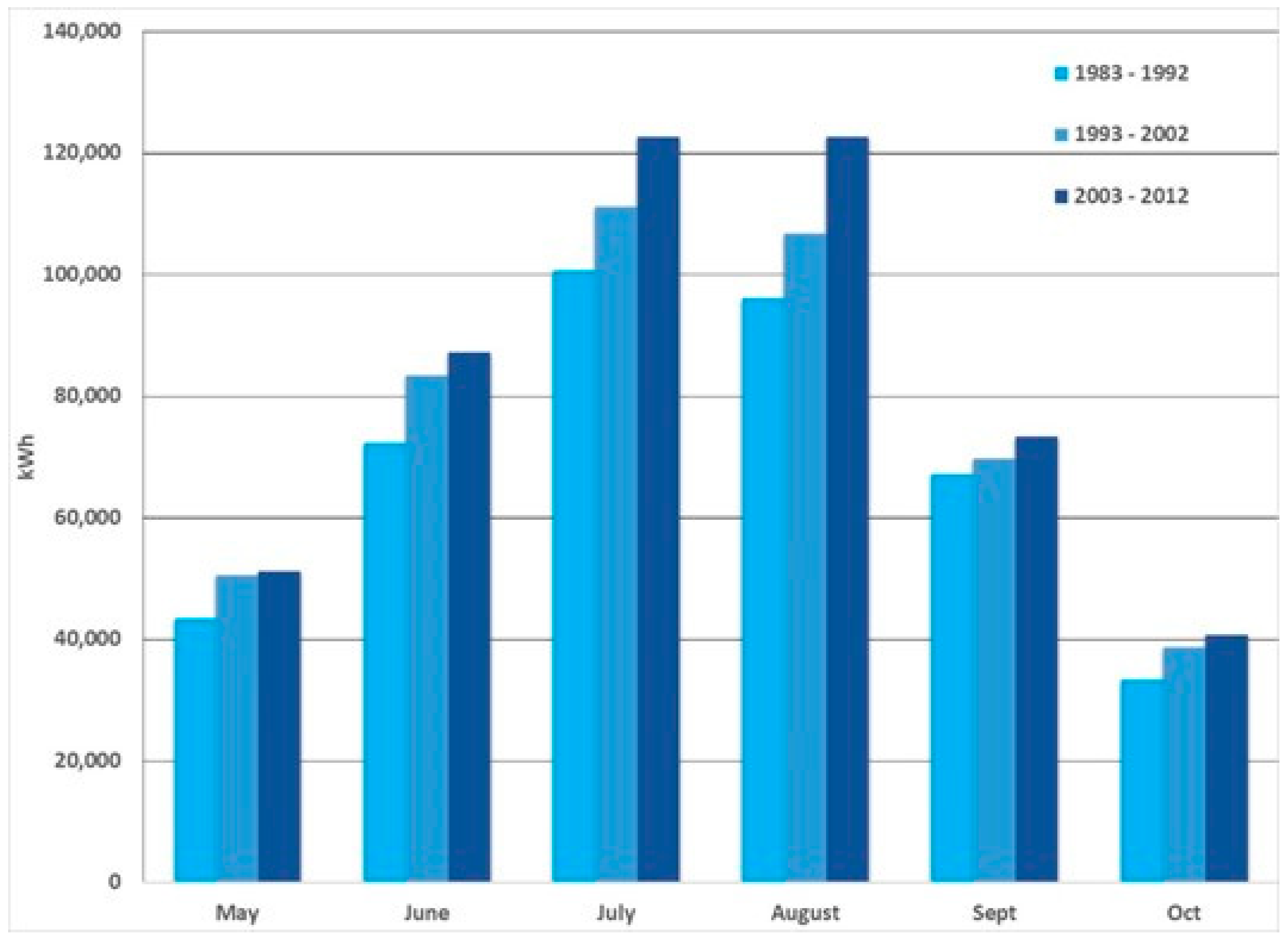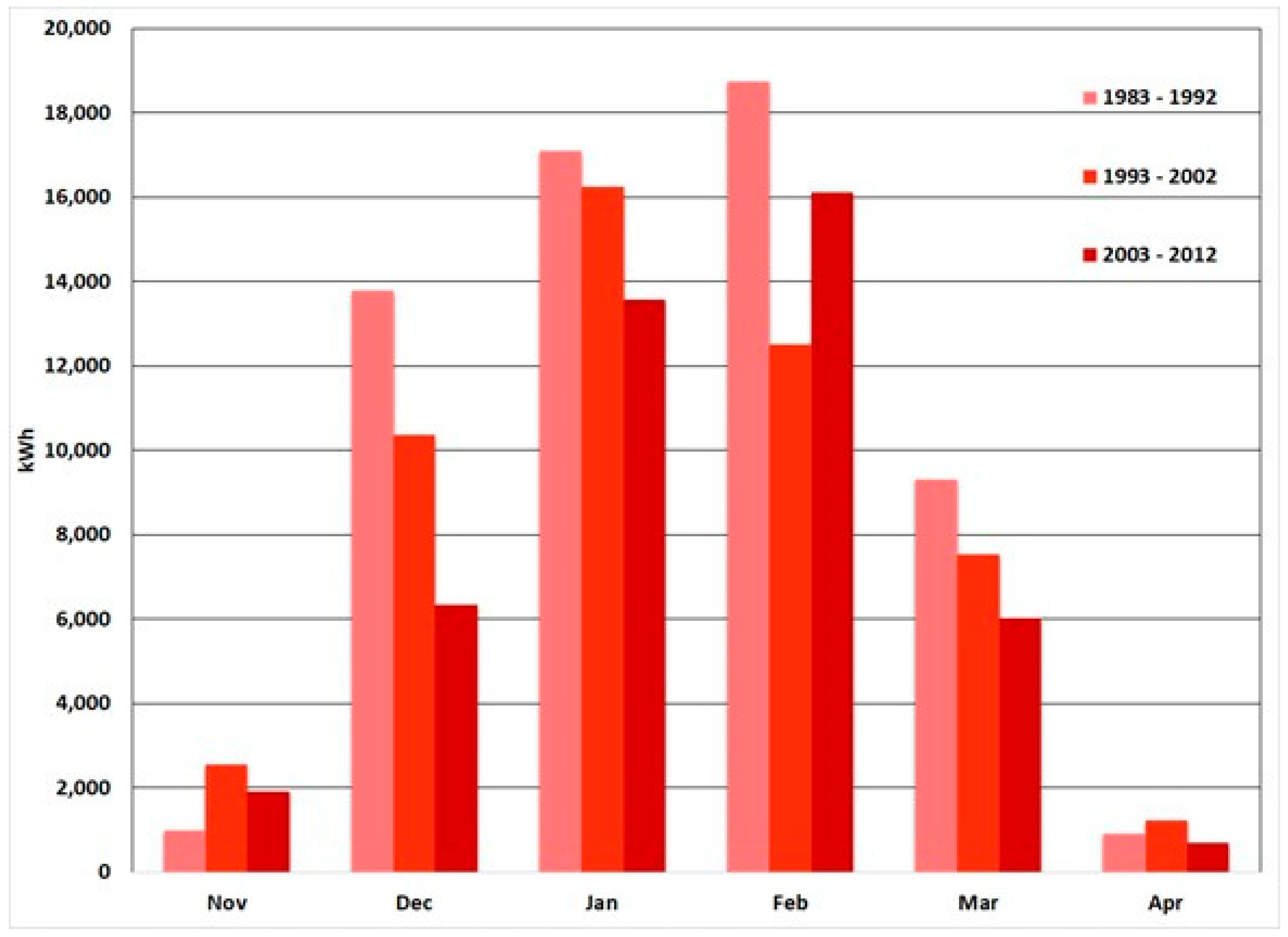The hourly time series of ambient air temperature and relative humidity of a thirty-year period (1983–2012) for the city of Athens were thoroughly analyzed in the frame of the current study. The data records were obtained from the meteorological station of the NOA [
13], located on a small hill near the Acropolis (38°00′ N, 23°433′ E) at an elevation of 107 m above sea level and at a distance of about 5 km from the coastline. The station is situated near the historic city center, but it is isolated from heavy traffic and densely built areas, thus it is not influenced by possible urban heat island effects. The elevation of the station is similar to the average elevation of the city of Athens. Data have been checked for homogeneity [
34] and missing values were negligible (less than 0.04%), thus not affecting the reliability and quality of the results.
Athens, the capital of Greece, is a large metropolis situated at the Eastern Mediterranean. The Athens metropolitan area hosts approximately 3.2 million residents and concentrates the largest part of the commercial, financial, societal and cultural activities of the country. The city center and most municipalities around it are densely built and only distant suburbs are more spacious. Athens enjoys the typical Mediterranean climate with wet, mild winters and warm, dry summers [
35]. The climate type of the city, following the updated Köppen–Geiger climate classification is (Csa). July and August are the hottest months of the year, whereas January and February are the coldest.
Athens’ average temperature has been increasing during the last decades [
36,
37]. Rapid and intensifying urbanization combined with the effects of global and regional warming have affected local climate conditions [
35,
38]. In 2007, the highest temperature ever since the mid-19th century (44.8 °C, on 26 June 2007) [
39] was recorded, in 2010 the highest mean annual temperature was observed, and the summer of 2012 was the hottest summer ever recorded [
40]. According to recent studies [
39], hot summer conditions that rarely occurred during the historical 160-year air temperature records of NOA may become the norm by the middle and the end of the 21st century. The results of the analysis are given in the following sessions.
3.1. Mean Monthly Air Temperatures
The mean monthly air temperature values were calculated from hourly measurements and then integrated for each of the 10-year time periods, namely 1983–1992, 1993–2002 and 2003–2012. The results are presented in
Table 1 and plotted in
Figure 1. From the results, it is concluded that the average annual temperature in Athens increased by 0.73 °C from the first time period (1983–1992) to the second time period (1993–2002) and by 0.38 °C from the second to the third time period (2003–2012). The total increase of the annual average temperature for the 30-year time period was 1.12 °C.
The rise in temperature ranges from 0.60 °C in September to 2.30 °C in August during the summer period. Respectively, the rise in temperature ranges from 0.10 °C in February to 1.42 °C in December over the winter. The only exception in the rising trend between the 10-year time periods is February, which in the third time period (2003–2012) shows a lower mean monthly air temperature compared to the second time period (1993–2002), but by comparing the last and the first period the final temperature increase is 0.10 °C, as mentioned above.
In May and October, which are considered transient months between the hot and the cold period, the increase is 1.35 °C and 1.03 °C, respectively. The comparisons are between the first and the third time period, leading to the conclusion that the mean monthly temperatures have increased in both winter and summer during the whole period, a fact highlighting the effects of global and regional warming in the area.
The positive trend of the mean air temperature in Athens has also been reported in other studies [
35,
37] and is consistent with the observed trends on a regional scale concerning many areas of the Eastern Mediterranean [
41].
3.2. Dry-Bulb Air Temperature Bin Data
Annual or monthly aggregated values are useful for energy calculations only in the case that an average efficiency or performance of the HVAC equipment over the entire heating or cooling season is considered. The main problem with the mean annual and monthly temperature data and average efficiency ratings is that they do not account for equipment performance variations that occur hourly in response to weather changes. In the case of air source heat pumps, air cooled chillers and even condensing boilers, the efficiency varies with outdoor air temperature, thus disaggregated data are needed. Bin data, as mentioned in the previous section, are temperature data sorted into discrete groups (bins) of dry-bulb temperature conditions. Each bin contains the average number of hours of occurrence during a month, period or year of a particular range of dry-bulb temperature conditions along with the corresponding mean coincident wet-bulb temperature or humidity ratio. Thus, instead of using a single design condition for an entire month or year, heating, cooling or ventilation loads of a building can be calculated for each bin condition. In this work, binned distributions of outdoor air temperature for the 1983–1992, 1993–2002 and 2003–2012 time periods were calculated from hourly measurements. The frequency of occurrence (in h) of outdoor temperature in each equally sized temperature interval (bin) was calculated for each year separately, and then the results (the bin data) were averaged for the whole 10-year period. The cumulative results for the frequency of occurrence of 2 °C-wide temperature bins during the summer season (June to September), when buildings usually need cooling, during the winter season (November to April), when buildings need heating, and the transient months (May and October) when normally neither cooling nor heating is needed, but in buildings with forced ventilation systems the ventilation loads have to be considered, are presented in
Figure 2,
Figure 3 and
Figure 4, respectively. The figures show the average number of hours that a particular temperature interval (bin) occurs in each season, for the three 10-year time periods separately. It is evident that the frequency distribution of temperature bins is shifting to the right, with a decrease in the low temperature bins and an increase in the high temperature bins every decade. It must be noted that some extreme temperature bins, with very low frequency, which represent very small percentages of hours during the heating season, the cooling season and the transient months (0.2%, 0.1% and 0.1%, respectively), were excluded from the results that appear in the figures.
During the cooling season (
Figure 2), the frequency of occurrence (in h) of the temperature bins which are lower than 26 °C decreases progressively, (with some exceptions in some bins during the third decade), while it increases above this temperature threshold in every decade. The 24/26 °C interval is the most frequent temperature bin in the cooling season during the first 10-year period, 1983–1992 (
Figure 2), with a frequency of 542 h of occurrence and a percentage frequency of 18.5%. The frequency of occurrence of this bin decreased to 497 h (17%) during the last 10-year period 2003–2012. In this last period, a higher temperature bin of 26/28 °C was the most frequent, with 529 h frequency of occurrence and a percentage frequency of 18.1%. Furthermore, the frequency of occurrence of the high temperature bins (>30/32 °C) almost doubled from 473 to 793 h, while peak temperature bins (>34/36 °C) more than tripled from 60 to 216 h.
During the heating season, the temperature threshold under which the frequency of temperature bins has decreased (and above which, respectively, it has increased) is 14 °C (
Figure 3), a typical balanced temperature for very well-insulated buildings.
The corresponding most frequent temperature bin during the heating season is the 10/12 °C interval, with 758 h frequency of occurrence and a percentage frequency of 17.2%, but the frequency of this bin decreased to 698 h (16%) during the last 10-year period 2003–2012 and it was substituted by the 12/14 °C interval, with 780 h frequency of occurrence and a percentage frequency of 17.9%. On the other hand, a reduction from 976 to 757 h was observed in the occurrence of low temperature bins (<6/8 °C) while the occurrence of the temperature bins below 0/2 °C was reduced from 70 to 55 h. During the transient months, the same tendencies are observed (
Figure 4).
The same trends, namely the increase of the frequency of hot days as well as the increase in number and duration of heat wave episodes (sequence of consecutive hot days), are observed by other researchers [
35,
37,
42,
43]. It is apparent that summers are becoming increasingly hotter, while the differences between the three decades during wintertime are less pronounced, although not insignificant. In general, the results confirm that for the city of Athens, the mean air temperature is constantly increasing and the climate is changing to relatively milder winters and harsher summers, which in turn leads to a decrease of energy consumption for heating purposes but also to a steep increase in energy consumption for cooling purposes [
44,
45,
46].
The above analysis for the mean monthly air temperatures and dry-bulb air temperature bin data of Athens was also performed in a previous work [
47]; nevertheless, the study did not make use of the revised version of NOA’s temperature data after the correction of detected inhomogeneity related to instruments change [
34], as at the time they were not available. More specifically, two discontinuities were detected in the air-temperature time series at the meteorological station of the NOA. The first discontinuity reflects the instrumental change which took place in June 1995 and the second discontinuity (and most pronounced) reflects the application of a correction factor to the temperature values (in January 1997) after a calibration of the new thermometers. Before applying these changes, a significant number of temperature measurements during the second period of the present study (1993–2002) were incorrect. The present study makes use of the revised (homogenized) air temperature time series. Furthermore, in addition to the calculation of frequency (in hours) of outdoor air dry-bulb temperature, the corresponding values of the mean coincident humidity ratio and the mean coincident wet-bulb temperature (MCWB) at each temperature interval were calculated.
Namely, in this study, a humidity analysis was performed in addition to the temperature analysis in the three 10-year periods.
3.3. Estimation of the Mean Coincident Humidity Ratio
Hourly measurements of outdoor air dry-bulb temperature and relative humidity for the same period were used to calculate the humidity ratio of the air. The missing values in the examined period were about 1177 out of 262,992 observations recorded (0.4%) and the effect on the results was negligible.
Air humidity influences the energy consumption of an HVAC system, making the use of accurate data of paramount importance in the precise estimation of its energy consumption. Furthermore, when applying the modified bin method, the mean coincident absolute humidity values or the mean coincident wet-bulb temperature values corresponding to every temperature bin are necessary for the calculation of latent energy ventilation loads when evaluating HVAC systems.
Several constituents, including water vapor and other components, are found in atmospheric air (e.g., smoke, pollen, gaseous pollutants, etc.). The term “dry air” refers to air that is free of water vapor and other contaminants. Dry air and water vapor form moist air, which is a binary or two-component mixture. Humidity ratio of moist air is defined as the ratio of the total mass of water vapor to the mass of dry air contained in the mixture at the same temperature and pressure [
48].
where:
the atmospheric pressure, in Pa;
the partial pressure of dry air, in Pa;
the partial pressure of water vapor content in air, in Pa.
To calculate the humidity ratio
W, the calculation of
and
is required. The value of the atmospheric pressure depends on the altitude according to the following equation:
where
Z is the altitude in m above sea level. The partial pressure of water vapor
is related to the relative humidity
as:
where:
the relative humidity of moist air;
the saturation pressure of water vapor at the air dry-bulb temperature corresponding to in Pa.
The saturation pressure can be determined as a function of dry-bulb temperature. For the temperature range from −100 °C to 0 °C, it is given by Equation (4), while for temperatures above 0 °C and up to 200 °C it is given by Equation (5) as follows:
where
T is the absolute dry-bulb temperature in K.
The calculation procedure of the mean coincident humidity ratio for every temperature bin of 2 °C, in each month of the 30-year period, was the following:
For each month, a file with pairs of dry-bulb temperature and the corresponding relative humidity (t, φ) from the hourly records of NOA was created. In this file, the 24 h of the day were divided into six 4-h periods. For each pair of (t, φ) the humidity ratio was calculated using Equations (1)–(5). The values of dry-bulb temperature were categorized in bins of 2 °C and the average, maximum and minimum value of humidity ratio at each bin and 4-hour period of the day were calculated. Additionally, the average (mean coincident) humidity ratio and its range were calculated at each bin of 2 °C, for the whole day (24-h period). This procedure was followed for all months of each year of the three 10-year periods, namely 1983–1992, 1993–2002 and 2003–2012. Finally, the mean coincident humidity ratio values for each month and at each temperature bin were integrated for the whole 10-year period, and seasonal (winter, summer and transient) values were extracted. A comparison of the results between the three 10-year periods is shown in
Figure 5,
Figure 6 and
Figure 7. As in the previous section, extreme temperature bins with very low frequency of occurrence were excluded from the results presented in figures.
In the cooling season (
Figure 5), the humidity ratio has increased in almost all temperature bins (except for very high temperatures), when comparing the last 10-year period (2003–2012) with the first (1983–1992). The average increase of humidity ratio in the whole range of temperature bins is 0.0007 kg H
2O/kg dry air (approximately 7.2%). During the heating season (
Figure 6), it rises in all temperature bins above 10/12 °C with an average increase of 0.0002 kg H
2O/kg dry air (2.1%). The temperature bin 24/26 °C is an exception, probably because the sample is very small. The same trends are observed during the transitional months (
Figure 7) with an average increase of 0.0004 kg H
2O/kg dry air (5.3%) between the two 10-year periods.
During the winter months, and particularly in January and February, there was an average rise in mean absolute humidity of 0.0003 (5.2%) and 0.0002 kg H2O/kg dry air (4.2%), respectively. During summer months the mean humidity ratio appears to have a stronger upward trend, with August showing a 0.0012 kg H2O/kg dry air increase (10%), while the average increase in July and September was 0.0008 and 0.0007 kg H2O/kg dry air, respectively (7.3% in both months). No noticeable changes were observed during the remaining summer or winter months. An upward trend of the maximum values of humidity ratio is also observed in all months, with its peak during the summer season.
From these comparisons it becomes apparent that there is an increase of the mean absolute humidity ratio in the outdoor air, with a gradual increase throughout the 30-year study period. This increase has an impact on the energy consumption required for the mechanical ventilation in buildings [
49]. The energy consumption for dehumidification of outdoor air during the summer season is increased and for humidification during winter is decreased in HVAC systems.
3.4. Estimation of the Mean Coincident Wet-Bulb Temperature
The mean coincident wet-bulb (MCWB) temperatures were calculated with the use of Daikin Psychrometrics software [
50]. First, the middle temperature value in each temperature bin was considered as the dry-bulb temperature. For every couple of dry-bulb temperature and coincident mean humidity ratio, the coincident wet-bulb temperature was estimated. The calculation procedure was as follows: the value of dry-bulb air temperature was kept constant, and the relative humidity was modified until the humidity ratio converged to the value of the mean coincident humidity ratio. The corresponding wet-bulb temperature was the MCWB temperature of the temperature bin. This method was applied for all temperature bins, in every month of the three 10-year periods.
The variations of the MCWB temperature follow the same trend with those of the mean coincident humidity ratio. In general, an increase of 0.6, 0.8 and 0.6 °C for July, August and September is evidenced between the first and the third 10-year period, while during the overall summer period it has increased by 3%. In the transient months, there was also a significant increase of the MCWB temperatures by 2.1%, while in the winter period there was a small rise of 1%, with the highest increase of 0.3 °C and 0.2 °C observed in January and February, respectively.
In similar works, observations and/or simulations indicate that the increase in air temperature is accompanied by an increase in the humidity ratio but also in changes in the maximum wet-bulb temperatures [
51]. There is the danger that simultaneous occurrence of higher air temperature and humidity could make climate conditions in some areas intolerable to humans in the future [
52].
